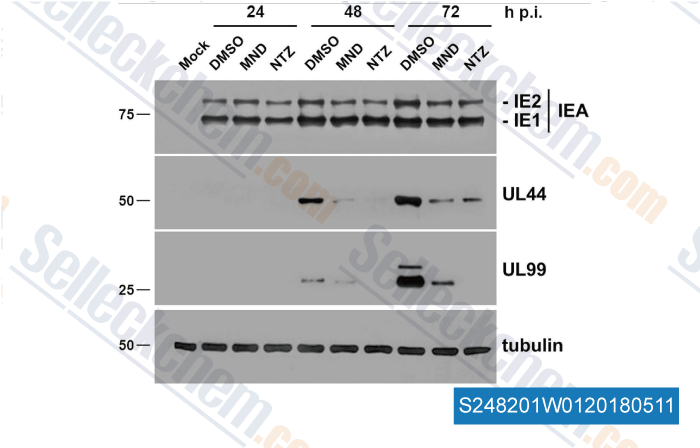|
Toll Free: (877) 796-6397 -- USA and Canada only -- |
Fax: +1-832-582-8590 Orders: +1-832-582-8158 |
Tech Support: +1-832-582-8158 Ext:3 Please provide your Order Number in the email. |
Technical Data
| Formula | C35H38N4O6.2HCl |
||||||
| Molecular Weight | 683.62 | CAS No. | 89226-75-5 | ||||
| Solubility (25°C)* | In vitro | DMSO | 100 mg/mL (146.28 mM) | ||||
| Water | Insoluble | ||||||
| Ethanol | Insoluble | ||||||
| In vivo (Add solvents to the product individually and in order) |
|
||||||
|
* <1 mg/ml means slightly soluble or insoluble. * Please note that Selleck tests the solubility of all compounds in-house, and the actual solubility may differ slightly from published values. This is normal and is due to slight batch-to-batch variations. * Room temperature shipping (Stability testing shows this product can be shipped without any cooling measures.) |
|||||||
Preparing Stock Solutions
Biological Activity
| Description | Manidipine 2HCl (CV-4093) is a HCl salt form of Manidipine, which is a calcium channel blocker with IC50 of 2.6 nM, used clinically as an antihypertensive. Phase 4. | ||
|---|---|---|---|
| Targets |
|
||
| In vitro | At a holding potential of −37 mV, Manidipine decreases the Ca2+ current at concentrations above 0.1 nM, and abolishes it at 100 nM. [1] Manidipine concentration-dependently inhibits the calcium concentration response curves. Manidipine inhibits coronay artery and renal artery with pIC50 of 9.3 nM and 9.1 nM, respectively. [2] Manidipine partly inhibits sympathetic nerve activity and suppresses the mean arterial pressure response to infused norepinephrine. Manidipine also inhibits aldosterone secretion. Manidipine increases in both urinary calcium and uric acid. [3] In addition, Manidipine, at nanomolar concentrations, is efficacious in modulating gene transcriptions that are involved in proinflammatory changes of mesangial cells. [4] | ||
| In vivo | Manidipine (3 mg/kg and 10 mg/kg, p.o.) dose-dependently decreases systolic blood pressure in the three types of hypertensive rats. At the dose of 10 mg/kg, Manidipine decreases the blood pressure to the normotensive level between 1 hour and 3 hours after Manidipine is administered; the antihypertensive effect lasted for at least 8 hours. [5] When Manidipine is administered at 10 μg/kg, the hypotensive action is markedly augmented. [6] Manidipine potently inhibits the Ca inward current, When the potential is at -60 mV. Manidipine consistently inhibits the Ca current evoked by depolarization to 0 mV. However, a low concentration of Manidipine (1-3 nM) enhances the Ca current evoked by the depolarizing pulse of -20 mV, when the membrane potential is held at -80 mV. Inhibition of the Ca current induced by Manidipine develops slowly and over 10 minutes is required to reach the maximum inhibition. [7] |
Protocol (from reference)
| Cell Assay:[4] |
|
|---|---|
| Animal Study:[5] |
|
References
Customer Product Validation

-
Data from [Data independently produced by , , Antiviral Res, 2018, 150:130-136]
Selleck's Manidipine 2HCl has been cited by 4 publications
| UGT8 mediated sulfatide synthesis modulates BAX localization and dictates apoptosis sensitivity of colorectal cancer [ Cell Death Differ, 2024, 10.1038/s41418-024-01418-y] | PubMed: 39580596 |
| Selective Translation of Maternal mRNA by eIF4E1B Controls Oocyte to Embryo Transition [ Adv Sci (Weinh), 2023, 10(11):e2205500] | PubMed: 36755190 |
| HCMV-IE2 promotes atherosclerosis by inhibiting vascular smooth muscle cells' pyroptosis [ Front Microbiol, 2023, 14:1177391] | PubMed: 37234524 |
| Evidence for Specific Receptor-Mediated Toxicity of Pharmaceuticals in Aquatic Organisms Derived from Acute and Chronic Standard Endpoints [ Environ Toxicol Chem, 2021, 10.1002/etc.5018] | PubMed: 33595135 |
RETURN POLICY
Selleck Chemical’s Unconditional Return Policy ensures a smooth online shopping experience for our customers. If you are in any way unsatisfied with your purchase, you may return any item(s) within 7 days of receiving it. In the event of product quality issues, either protocol related or product related problems, you may return any item(s) within 365 days from the original purchase date. Please follow the instructions below when returning products.
SHIPPING AND STORAGE
Selleck products are transported at room temperature. If you receive the product at room temperature, please rest assured, the Selleck Quality Inspection Department has conducted experiments to verify that the normal temperature placement of one month will not affect the biological activity of powder products. After collecting, please store the product according to the requirements described in the datasheet. Most Selleck products are stable under the recommended conditions.
NOT FOR HUMAN, VETERINARY DIAGNOSTIC OR THERAPEUTIC USE.
